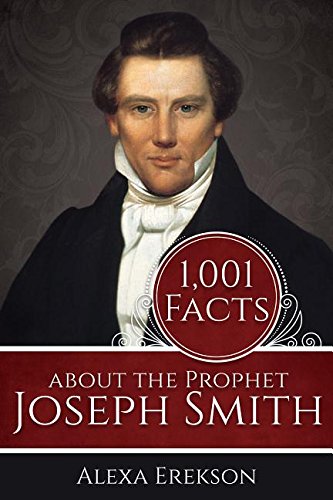
This is a short (151 pages) paperback book that contains 1,001 numbered paragraphs that chronologically narrate the life of Joseph Smith, essentially constituting a simple biography. “One of the main goals of this book is to tell the real story, while making it simple to read and understand. 1,001 Facts about the Prophet Joseph Smith is a history book for this generation. The entire book can be read in one sitting, or readers can jump around to different moments in the prophet’s life and learn about their favorite and the more fascinating events” (page 2). The author also intends the book to combat the anti-Mormon propaganda being spread on the Internet.
Here are several examples from the book that I thought were of interest:
- Lucy often went to pray in groves near her house even before she lived in Palmyra. It is likely that Joseph learned to pray seriously in the woods from his mother’s example.
- While living in Randolph, Maine, after she had Alvin and Hyrum, Lucy became extremely ill. The doctors said she was going to die. She made a promise to God that she would serve Him the best she could if He would let her survive this illness. She heard a voice say to her that she would be healed because she faithfully asked God. She was healed in just a few moments. After this, she became consumed with the subject of religion and began her search for the truth. Eventually she realized that she felt there was not a true religion on earth at the time, so she relied on the teachings of the Bible.
- There are nine known written accounts of the First Vision. There are four firsthand accounts of Joseph himself and there are five accounts recorded by those who heard the Prophet speaking about his experience.
- Martin Harris’s wife, Lucy Harris, frequently tried sneaking a peek at the golden plates. Once, she came with her husband to where Joseph was living in Pennsylvania. She searched the entire house and could not find them. Instead, she investigated outside the house. She found an area where she was sure the plates had to be buried. She was about to start digging for them, when a big black snake slithered up to her and hissed. She ran away screaming, forcing her to give up her search. It was winter, and Emma later stated that there were normally no snakes in the area.
- The words in the original manuscript of the Book of Mormon are sort of crowded together in groups of about twenty-eight to thirty words. This suggests that Joseph could see twenty-eight to thirty words at a time while translating. He would dictate them to his scribe, and then they would move on to the next twenty-eight to thirty words.
- To legally start an official church in 1830, Joseph Smith only needed six official members. However, there were several friends and family members also invited to the first Church meeting.
- While translating the Bible, Joseph and his family lived with John and Elsa Johnson on their farm. Before meeting the prophet, Else Johnson had a handicap in one of her arms which caused her crippling pain and limited her movements. Joseph Smith gave her a blessing and she was immediately healed. She never had any problems with her arm again. She and her husband were converted to the gospel because of this.
- In September 1843, Emma Smith was the first woman to receive her endowment. Joseph instructed her how to officiate temple ordinances for other women. She did so until shortly before Joseph’s death. Emma Smith was the only woman in this dispensation to be given authority to officiate temple ordinances from the Prophet Joseph Smith himself.
The book covers many of the controversial aspects of Joseph’s life, such as the various accounts of the First Vision, the Book of Abraham, the failure of the Kirtland Safety Society, polygamy (including polyandry), and Freemasonry. The author spends some time providing context and explaining each of these; however, some of the explanations are better than others. (The section on the Book of Abraham is downright horrible – John Gee’s An Introduction to the Book of Abraham is where you should go for information on that.) But generally a good introduction to these topics is provided, and an interested reader can then look into other good sources for additional information.
Unfortunately, there are no footnotes in this book. There are some sources given in a handful of cases where there are direct quotes, but otherwise the only source information is a two page bibliography in the back. However, most of these are primary sources, and they all appear to be reliable.
For those that are not very familiar with Joseph Smith and would be overwhelmed with a more comprehensive biography, this is a good place to start. It also fulfills its goal to an extent of providing inoculation against many of the falsehoods that one may come across far too easily online today.
